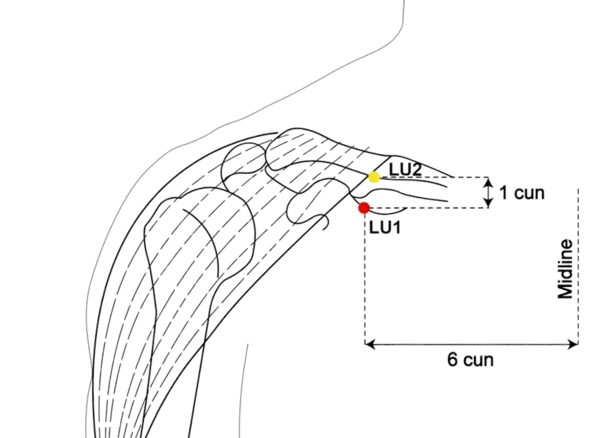LU-1 - Middle Palace
中府 - Zhōng fǔ
Point Region: Chest
LU-1 Zhongfu, meaning "Central Treasury" or "Middle Palace," is the first point on the Lung meridian and serves as the crucial entry point for Lung Qi into the body's energy system. Located in the subclavicular fossa below the lateral third of the collarbone, this point acts as a treasury where the body stores its most vital respiratory energy.
As both the Lung meridian's starting point and a crossing point with the Spleen meridian, LU-1 has powerful regulatory effects on breathing, immune function, and the body's ability to distribute nutrients and energy. It's particularly valuable for opening the chest, clearing congestion, and strengthening overall vitality.
Location & How to Find
Anatomical Location: Located slightly below the clavicle, lateral to the sternum, in the first intercostal space.
How to Locate:
- Find your collarbone (clavicle)
- Move down below your collarbone toward your chest
- Find the first space between ribs below your collarbone
- The point is in this space, outward from your breastbone

Primary Functions
Respiratory System
- Regulates lung qi and breathing
- Relieves chest tightness and congestion
- Treats cough and asthma
- Improves oxygen circulation
- Reduces shortness of breath
Immune & Energy System
- Strengthens defensive qi (wei qi)
- Boosts immune system function
- Increases overall energy and vitality
- Prevents frequent colds and infections
Emotional & Mental
- Releases grief and sadness
- Promotes emotional letting go
- Reduces depression and melancholy
- Enhances mental clarity
Musculoskeletal System
- Relieves shoulder and arm pain
- Treats chest and upper back tension
- Reduces muscular stiffness in upper body
Clinical Applications
Primary Indications
- Cough
- Asthma
- Chest pain
- Chest fullness
- Chest congestion
- Pleurisy
- Respiratory problems
- Breathing difficulty
Related Health Concerns
Common Conditions:
Related Acupoints
Select a point to learn about its location, primary functions, clinical applications, and protocols.
LU-1 Protocols
N/A
Important Precautions
- Recent chest surgery
- Severe respiratory distress
- Chest wall injuries
- Pneumothorax history